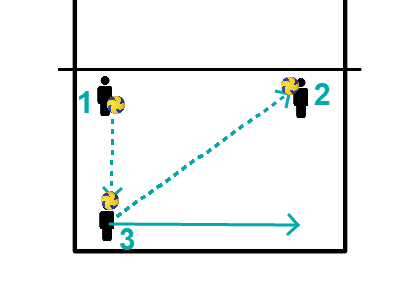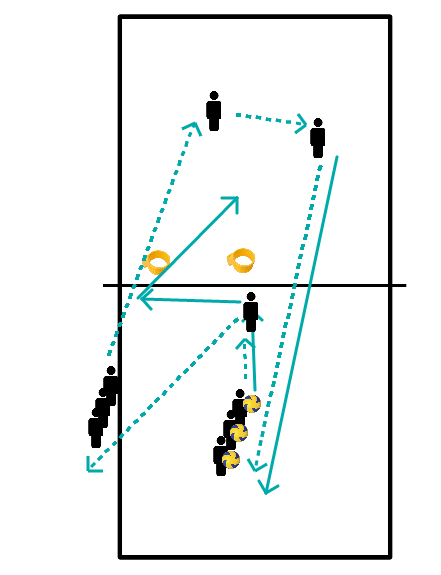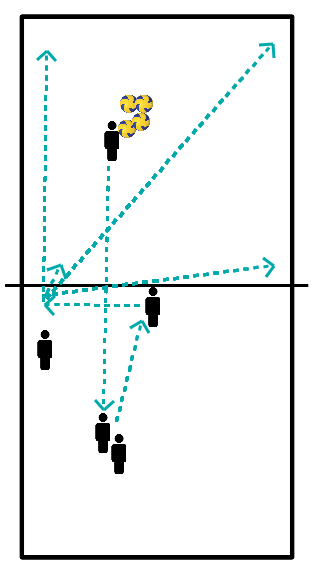Volleyball drills
- The players are randomly placed in the field.
- The ball is caught and immediately thrown over the net (play 1 time).
- The player throws the ball as he catches it. When the player has thrown the ball, he/she will go to the wall (in the back of the field or on the side), touches it, and comes back into the field.
- The other players have rotated a spot.
- When someone throws a foul (in the net or outside), he has to run around the field of the opponent
- Possibly...chaos, in which you have to play the ball instead of catch it.
make 2 or 3 rows of 2 benches after each other (lengthwise)
players walk in file on the benches in a slow tempo
oefening 1
- with left leg on bench
- bend left knee
- bring right leg from back to front along bench
- stretch left leg during this movement
- same with right leg on bench
exercise 2
- 1 leg on the bench, 1 leg on the ground
- jump up
- properly swing arms from your back to as high as possible
- land in the jump with other leg on bench
exercise 3
- both legs next to the bench (bench between legs)
- jump on the bench with both legs
- properly swing arms from your back to as high as possible in the jump
- and step off the bench
exercise 4
- both legs on one side of bench
- jump with both legsON the bench
- properly swing arms from your back to as high as possible in the jump
- and step off the bench
exercise 5
- both legs on one side of the bench
- jump with both legs OVER the bench
- properly swing arms from your back to as high as possible in the jump
zie????https://www.youtube.com/watch?v=pxXBp03Szdc
- Now they are all holding 1 hoop and the trainer throws the ball high over the net.
- The ball has to go through the hoop before the bounce.
- Bring the ball to the trainer and join the back of the line.
The trainer is on one side of the net, the children are on the other side of the net in a line behind the end line
The first of the line enters and performs the exercises
- 2 upper arms in the neck, let bounce, and catch
- Let bounce between the legs, turn around, and catch.
- Let bounce on two upper legs with jump and catch.
- Let bounce on 2 insteps with jump and catch.
- Let bounce on shoulder and catch.
- The caught ball in box at trainer and join the back of the line
Very important to catch the ball
Be enthusiastic, stimulate the children to catch the ball
The trainer is on one side of the net, the children are on the other side of the net in a line behind the end line
The first of the line enters and performs the exercises
- 2 upper arms in the neck, let bounce, and catch
- Let bounce between the legs, turn around, and catch.
- Let bounce on two upper legs with jump and catch.
- Let bounce on 2 insteps with jump and catch.
- Let bounce on shoulder and catch.
in trios:
- play 1 ball overarm, and throw 1 ball, both in the same direction
- play 1 ball overarm, and throw 1 ball in the other direction. (for example play left, throw right)
- play 2 balls overarm, same direction
- play 2 balls overarm and throw 1 ball, same direction.
in pairs opposite each other:
- keep 3 balls in the air while only keeping one ball in the hands at the same time.
- keep 4 balls in the air while only keeping one ball in the hands at the same time.
- 3 balls in total, with 1 ball thrown in between and both have 1 ball. Before you catch the ball thrown, you throw one of your own balls up, catch the bal thrown, throw it back, and catch your own ball etc.
- play ball overarm, bounce 1 ball in between via ground.
- play 1 ball overarm, play 1 ball over ground.
- play 1 ball underhand, roll 1 ball with stretched arms over ground.
pay attention in the exercises:
- Pass has to be high, so the player can catch 'overarm'.
- Pass to right, right foot front
- Pass to left, left foot front
- 'Eyes' of the shoulder in playing direction
The exercise:
- trios with 1 ball
- 1 and 2 are next to each other, not too close to the net.
- 3 is opposite 1 in the back of the field.
- 1 throws straight to 3, and 3 throws diagonally to 2
- 2 catches and then throws straight to 3 and 3 throws diagonally to 1.
- so 3 keeps moving

- trainer throws ball to centre player
- Who passes to SV
- SV sets up
- Attacker plays ball SLIM over the net
- so right over the net
- OR in the back of the field in the corners
- OPTION: the new playmaker calls HOOP (=wrong) or GOOD (=good) after the smart ball of the attacker
- Attacker gets the ball and puts it in the box at trainer
- Everybody keeps rotating one spot (walks after own ball)
- Possibly place hoops (= opponents) where theyshould not play
- Keep giving directions
- player 1 at net centre forward
- number; players centre back with ball
- line of players on left (or right) forward
- 2 baskets as obstacle/block on other side of the net
- 2 players as defense on the other side of the net
- player with ball throws to centre forward
- centre forward sets up HIGH
- left forward attacks
- if hitting does not work: play SMARTLY over the net
- if ball hits the ground in the field you score a point
- defenders try to prevent this.
- everybody keeps rotating
- throwers becomes playmaker
- playmaker joins line of attacker
- attacker goes underneath the net and becomes 1st defender
- 2nd defender takes the ball, walks underneath the net and joins line of servers

- A first there is one tagger
- The tagger has to tag as much children as possible.
- As soon as someone is tagged, he becomes a crab.
- The crab has to move on hands and feet with the belly upwards.
- As soon as a crab has tagged a walker, the crab is free again.
- After some time, someone else is appointed as tagger.
- A serves B
- B plays to C
- C sets up and B plays over net
- Walk after your own ball









